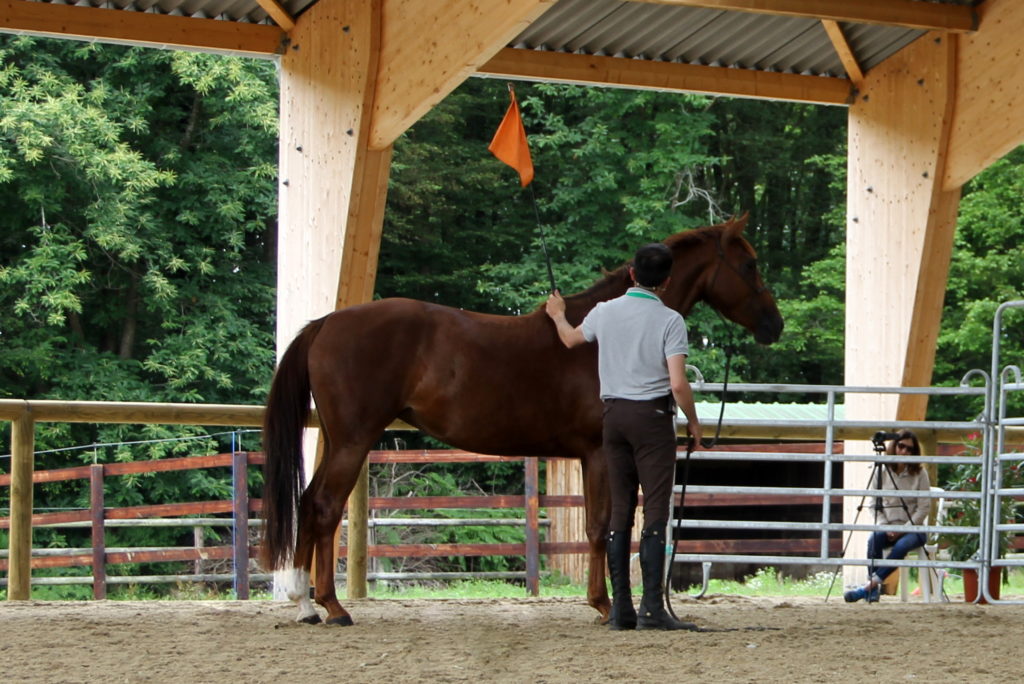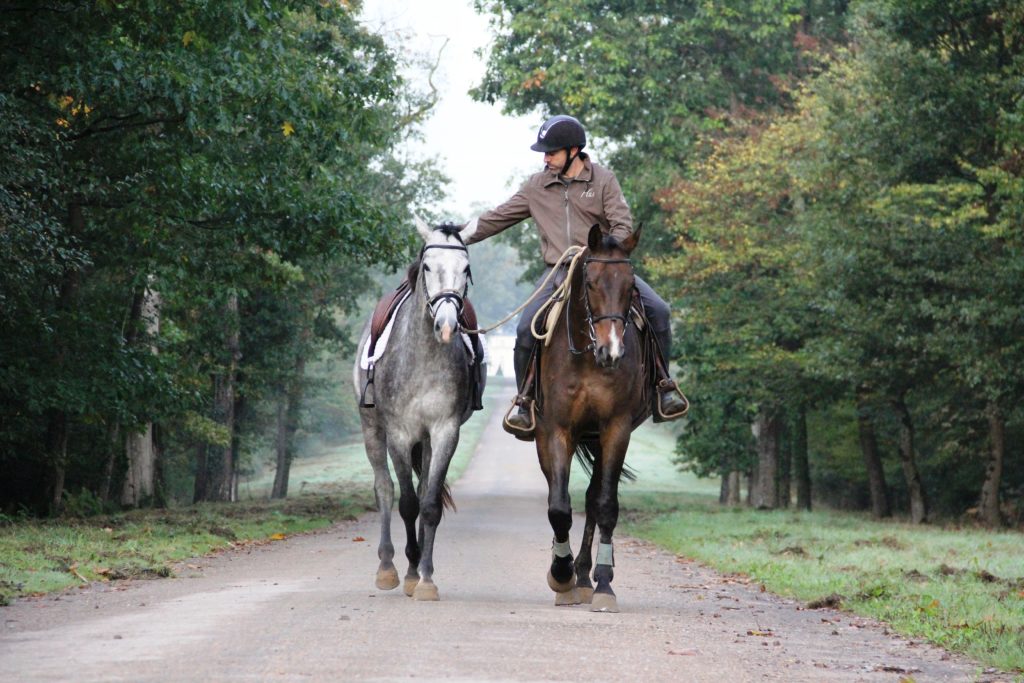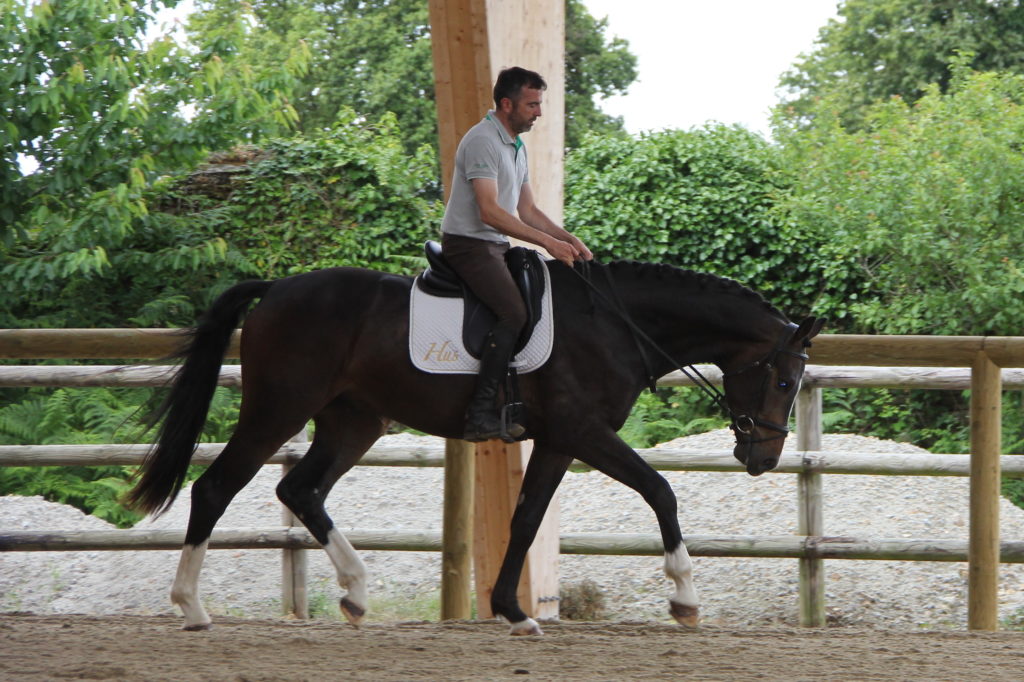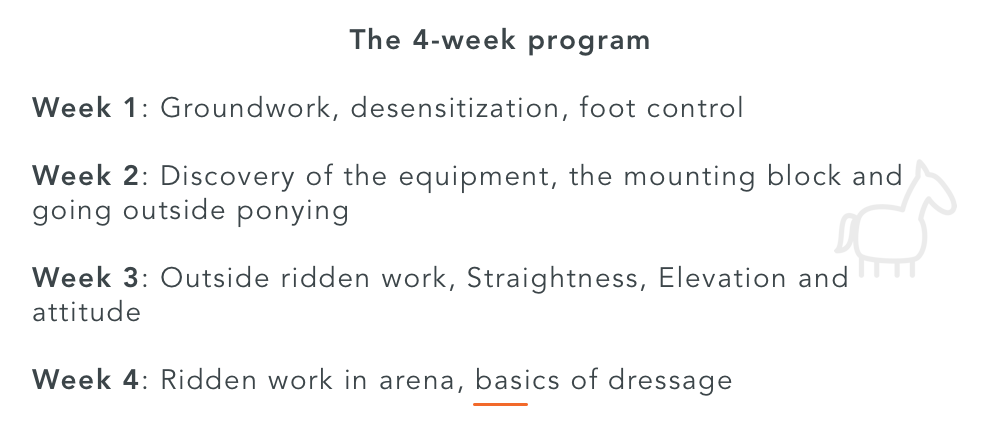
How to Break in Your Horse in 4 Weeks
Breaking-in is still regularly associated with bucking. This is often the case until one discovers that with an ethological approach, one can break in their horse in a calm and gentle way. To have some advice on this, I called on Sébastien Jaulin, ethologist and head of the Education Department at the Haras de Hus, a stud farm in France. He is in charge of all the breaking-in of horses on the farm!
Table des matières
- Ethology at the Haras de Hus?
- Where does the process of breaking-in a horse start and finish?
- The first manipulations start early!
- For good breaking-in, the physical condition of the horse must be taken into account.
- How they are broken in…
- What are the factors that influence the breaking-in of a horse?
- Follow your horse’s progress during and after breaking-in
- To Sum Up
Ethology at the Haras de Hus?
Yes, you read it right! The Haras de Hus has chosen ethology as the prefered technique for breaking-in their horses. With the results, it is proof that high-level education and ethology are compatible (as if it was still to be proven…).
The idea comes from wanting to maximize the horses’ well-being during this crucial period and with the results being there, the practice has continued! Thanks to this method, horses come out of the breaking-in period feeling good in their heads and fit for a great career!
As proof, I invite you to watch this demonstration that I witnessed with astonished eyes in Saumur in 2016. It is a 5 year old mare, from the Haras de Hus, broken in by Sébastien Jaulin. She is ridden in dressage by Manuel Godin of the Haras de la Cense, therefore he worked according to the principles of ethology. You will easily understand why this approach from breaking-in presents unquestionable advantages.
📚 Learn more on the topic : 10 horsemanship ethology principles every rider should know
Let’s dive in a little deeper and explore how the process for breaking-in 🔍
Where does the process of breaking-in a horse start and finish?
According to this dictionary, the definition of ‘breaking-in’ is: “to accustom (a horse) to the bridle and saddle, to being ridden, etc“
For Sébastien Jaulin, a horse’s breaking-in is over when basic dressage is acquired. This means two things:
- The horse is able to go outside (forest, road…) all alone.
- In the arena, they are able to make circles by responding to the inner leg, they know how to make in-gait transitions and they know how to sit on the contact.
Keeping this in mind, it can take 4 – 10 weeks of work and 5 – 6 sessions per week to get your horse where you’d like to be.
But let’s go though things in order and see the necessary prerequisites first.
The first manipulations start early!
At the Haras de Hus, basic training begins 15 days after weaning and foals are weaned between 8 and 12 months old.
💡 Learn more : Foal weaning, a good idea?
After the foal is weaned, they are introduced to basic handling and this training lasts 1 week. They learn how to respect the halter, how to walk with someone leading them, to be comfortable with someone touching them everywhere and finally how to respect boundaries with their handler.
This work is repeated again for another week when the foal is 1 year old and then again at the age of 2. Depending on the future use of the horse, they will be broken in between 2.5 and 3.5 years old.
For Sophie Bolze, breeder of Connemara ponies in the center of France, handling begins even before weaning:
“For early learning, I use the mother a lot. That’s how I teach them how to walk in hand, go to the shower, go to the lake and discover the arena … Everything is done with the mother and it has proven to be very effective. It’s much faster and the benefits are really felt when you then break them in.”
You can find Sophie Bolze on the Facebook page of her breeding farm, as well as on her website.
For good breaking-in, the physical condition of the horse must be taken into account.
When you break in your horse, you start a more intense physical activity. It is then common for your horse to lose weight, especially when your horse undergoes a change of environment. This is the case when horses arrive at the Haras de Hus for breaking in.
“During breaking-in, the horses must not be on edge. That’s why I prefer to have horses that are slightly overweight at the start rather than a little thin to avoid them losing too much condition. They’re fed hay at will and pallets in slightly higher doses than horses in regular work.”
– Sébastien Jaulin
The horse will also undergo a complete movement assessment before breaking-in. The aim is first, to not break-in a horse that is unfit, and second, to be familiar with any small peculiarities that horse may have before starting the breaking-in process. These peculiarities which are found are then taken into account when breaking-in. These horses will require special attention and the work is then adapted accordingly to them.
Finally, a dental check-up must be done beforehand and the wolf teeth need to be removed.
How they are broken in…
Let’s get down to business. The breaking-in takes place over 4 weeks, the horse is worked 5 to 6 times a week and also taken out twice a day: once for work with the rider and once in the paddock or walker.
Let’s now see the program:
Week 1 📅
The first week consists of thorough groundwork.
One of the ways to do this is through foot control. The rider must be able to control all four feet of the horse independently of each other.
The horse is also desensitized to usual handling and various stimuli such as a flag, tarp, throwing the lunge over the neck, etc.

The goal of this first week is to gain the horses confidence in its environment and to reduce its flight reflexes as much as possible in front of unknown elements.
⚠️ This is a crucial step for the future that can be failed very quickly if it’s done wrong. Typically, when the breaking-in lasts 10 weeks instead of 4, it’s because this step was otherwise skipped or not done correctly, therefore, this is clearly the most delicate stage.
Week 2 📅
On the program of the second week: discovery of equipment, the mounting block and riding beside other horses/being lead from another horse.
First, it is the work of desensitization in the mouth that is tackled. The horse discovers the bridle and the bit. It also discovers the lunge and long reins.
Then, the back is desensitized, the horse discovers the surcingle then the saddle. Quickly comes the work of the mounting block, left and right and then learning to be independent at the mounting blog (ie, not being held to stay stationary).
Finally, and this I think is the most impressive: being lead. It’s about getting on an old horse and holding the youngster in a halter next to the old horse. The rider and the two horses go outside like that!

In fact, the idea is to get the youngster used to seeing another horse being ridden and to see the rider in a higher position. It also allows to see if the horse has problems of socialization and to test its reactions to the environment.
If the work has been well done so far, there should be no violent reaction! The very purpose of this first week is to build the horse’s confidence and to desensitize them so that they learn not to run away anymore.
Week 3 📅
Once all this is acquired, get on horseback and go outside! 🏇🏻 Now it’s a matter of teaching the horse the basics of impulsion, straightness and attitude!
Also, as the horses that are broken in at the Haras de Hus are destined for a sporting career, they must learn the notion of effort right away. This can be tested by, for example, trotting or cantering for 4 km on a forest track. This outdoor work allows you to test their behavior outside their comfort zone.
Week 4 📅
Finally, the horse will discover arena work. The idea is that by the end of this week the horse will know the aids of basic dressage work.
The goal is to have a horse that knows how to do circles with a response to the inner leg, make in-gait transitions and have a steady contact pressure with a steady neck.
“When the horse is confident and waiting for the request, the dressage work is very fast. It requires, however, that the horse be calm, relaxed and not run away.” Sébastien Jaulin


What are the factors that influence the breaking-in of a horse?
There are 4 factors that can make breaking-in easier or more difficult.
The Rider’s Experience
It is very obvious, but it’s still important and to be mentioned.
The experience of a rider and the people handling the horse will facilitate or complicate breaking-in.
In fact, it is the small details that will influence the horse’s behavior and the ease with which it can be desensitized. The problem is that when we are not trained to these methods, we can quickly make mistakes … we reccomend for you to be accompanied during all the education of your young horse! It’s essential!
The education and experience of the horse before breaking-in
Depending on the type of education the horse has received before breaking in, it may be more or less complicated.
Thus, over-spoiled horses are more difficult to exercise and are easily clingy. On the contrary, horses that are handled very little respect the rider’s “living space” much better but are also more difficult to desensitize.
Apart from education in the strict sense of the word, the experience of the horse also has a huge impact.
Genetics
Genetics affect how easy it is to break-in a horse. Depending on the origins, horses will put in some effort easily but be delicate to desensitization, or it can be harder for them to put in this effort.
For example, thoroughbreds will be more delicate to desensitize but have no problem with the effort.
The character of the mother and father also has an impact! If you want to put your mare to stud, make sure you find out about the stallion’s character and history!
The Equipment
Breaking-in is THE moment when the horse builds its relationship with the rider. So, if the first saddle you put on is “the rotten saddle for breaking-in” which doesn’t suit them at all or even hurts them because it presses on the withers, they will automatically make the association {saddle = pain}. This pain will also be worsened with the presence of the rider.
👉 Hence the importance of paying a little attention to the equipment used at the breaking-in time.
Know more about this : How your saddle is keeping you from improving
“In the 30 years I’ve been breeding, I’ve always been the one to break in my foals. They’re born at my place, I handle them since they were born, I’m the one who teaches them everything. We break them in at their home, a place they know perfectly well so they feel confident. Breaking in itself is therefore only a formality! This is all the more true with the Connemaras as we break them in, in only 5 sessions. FSP with a horse origin is a little more delicate.”
– Testimony of Sophie Bolze who sums up the problem of breaking-in well !
Follow your horse’s progress during and after breaking-in
Breaking-in is a period of great transformation when it comes to the horses’ movement, as the horse has to adapt to the weight and movements of the rider. It is also the period that marks the beginning of its career and thus the beginning of its future progress.
Due to this, it can be very interesting to start monitoring its progress on the movement/rhythm and cardiorespiratory levels as soon as they’re broken in. All this is possible thanks to the Equisense Motion S connected sensor.
In particular, you will be able to follow the evolution of your horse’s elevation, symmetry, regularity of movement and heart rate during and after breaking-in, all of which can be easily read on the Equisense mobile app.
To Sum Up
The breaking-in of a horse corresponds to the beginning of their sporting career, it is also their first experience with riding. This experience must therefore be as pleasant as possible, otherwise, the rest of their career may be very complicated!
To achieve this, it is necessary to have a good knowledge of a horse’s learning process and to be well supervised from the beginning! It is therefore advised to call upon a professional from the beginning rather than to want to do it alone and risk mistakes!
If you have experience on breaking in your own horse, share your stories with us!
Camille Saute
Cofounder of Equisense
i have done these exercies before but the horse i have been working with for 3 years is still not able to be riden
I am currently breaking a cob and she is the softest pony! I have been on her bare back and she will happily follow someone who is walking infront. However, she will not move with vocal cues or with squeezes/kicks to the side. Have you got any ideas?
Thank you
i would try verry soft spears on her maybey englishe spears